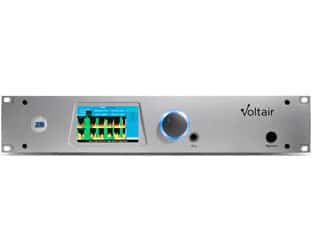 The Telos Alliance, parent of 25-Seven’s controversial Voltair Watermark Monitor and Processor, has released its free 2.3.2 software update.
The Telos Alliance, parent of 25-Seven’s controversial Voltair Watermark Monitor and Processor, has released its free 2.3.2 software update.
The latest version of Voltair includes new features and “enhancements,” and marks the first major field update since version 2.0 was released last year.
“Stations want to ensure that their watermark encoding is as good as it can be,” said 25-Seven founder Geoff Steadman. “Voltair is still making a positive difference in registering meter count and overall watermarking performance, even in this post-eCBET world. Not only are we confident this is so, we see our users doing their own research and arriving at the same conclusion while they continue to invest in Voltair technology.”
New sections are devoted to use of Voltair in conjunction with the Omnia.9 and Omnia.11 processor patch points for optimal processing performance. In addition, version 2.3.2 adds two new features: Encoder Distortion Testing and Display and Flexible Program Output.
Regarding Encoder Distortion Testing and Display, 25-Seven notes that, over the years, it has discovered that “some encoders, even when not actually adding watermark tones, may add noise or distortion to the audio signal. If this distortion is too high, Voltair will refuse to calibrate to the encoder.”
Since the calibration data in 25-Seven’s system logs provides information about signal health of individual encoders, the company converted its field experience into a diagnostic feature: Firmware 2.3.2 adds a new “Calibration” section to the external web information page showing the results of the distortion testing.
“This can be useful for detecting encoders whose audio path may be distorting a station’s feed,” Steadman noted.
Meanwhile, Voltair firmware 2.3.2 adds “Flexible Program Output,” allowing users to choose from PPM-encoded audio, enhanced by Voltair; PPM-encoded audio, straight from the encoder with no enhancement; the “Input from Studio” audio stream, with no watermark codes; or the “raw” PPM encoding tones added by the encoder, with no source signal.
“These outputs allow users to easily listen to the difference between unmodified studio audio, encoded audio, and Voltair-enhanced audio, making it easier to make enhancement level and processing choices that balance encoding robustness against perceivable audio artifacts,” the company said in a statement.
Nielsen Still Not Supporting Voltair
It’s been a year since the Voltair processor came under the scrutiny of Nielsen Audio. On July 21, 2015, in a web presentation moderated EVP of Local Media Client Solutions Matt O’Grady, SVP of Product Leadership Jennifer Huston and Chief Engineer Arun Ramaswamy, the nation’s leading provider of AM and FM radio ratings estimates concluded that Voltair “introduces audible artifacts for listeners” and “interferes with the encoding process by altering Nielsen watermarks and by making them audible.”
In short: The controversial audio processing system can, in extreme cases, affect the accuracy of one’s exposure to radio signals by the Nielsen Audio Portable People Meter (PPM).
This, along with the fact that Voltair is used by some but not all encoded radio stations, resulted in Nielsen declaring that it would not support Voltair.
The announcement, though, left some in the radio industry puzzled on what to do should they be using the system.
“Soooo…we don’t support Voltair, but we are not saying you must take it out of your Processing Racks???,” Nashville-based air personality Kenny Smoov Tweeted following the July 2015 call.
To cloud matters, Nielsen Audio barred the trade press from sitting in on the client-only call, open to representatives from the NAB and RAB in addition to radio station personnel and executives.
Among Nielsen Audio’s other conclusions on Voltair:
* PPM can pick up more codes with Voltair “in some situations where background noise is equal to or greater than the audio content.”
* Voltair generates variability; when the “dial is turned up,” the effect on the watermark and the codes is increased.
* The Voltair effect was more visible at the minute-level than at the adjusted quarter-hour level
New watermark improvements were being tested at the time, and it was originally anticipated that Voltair customers would have them by the end of 2015, effectively allowing stations to adjust gain for the watermark based on noise in the signal.
Overprocessing Issues Addressed
Steadman, 25-Seven’s founder, responded to a RBR + TVBR query about detected overprocessing of Voltair’s watermark and encoding at radio stations in Portland, Ore. and Miami, Fla.
He notes that “it is certainly possible that some stations have had their Voltair’s set too hot, but that’s what the knob is for.”
Steadman adds, “When eCBET was rolled out, it changed the watermarking math, and an enhancement level of say 22 that no one would have noticed could become quite noticeable under the new encoder formulation. Especially with eCBET, the downside of pushing your Voltair too hard in the hopes of lighting up meters is that you could actually drive the meter-wearing human listener away.”
RBR + TVBR OBSERVATION: The latest software release for Voltair, based on 25-Seven’s description of what it offers engineers, appears to have addressed—and resolved—noticeable issues regarding overprocessing of its watermark and encoding. For several weeks this summer, iHeartMedia’s WBGG-FM “Big 105.9” in Miami suffered from overprocessing issues that made the station very difficult to listen to when it was playing a block of Classic Rock. Big 105.9 is known for a Talk-intensive morning show. This brings up the question of Best Practices for stations using Voltair that have a Talk-intensive morning show and then shift to a predominantly music-based focus later in the day. Does the software upgrade address such issues, which resulted in music accompanied by an annoying “bong” or “underwater” effect? Or, is the application of Voltair ultimately up to the cluster’s chief engineer?





